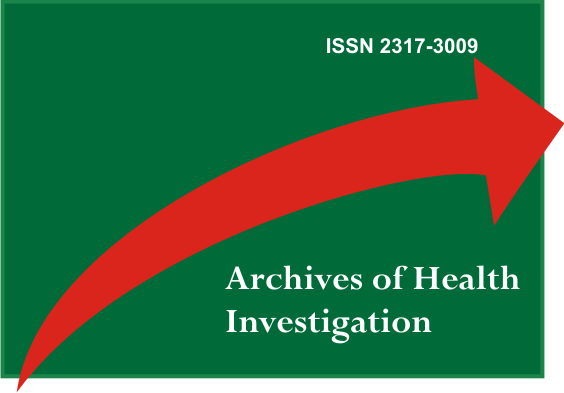Hipersensibilidade aos β-lactâmicos e outros antibióticos. Bases biológicas
DOI:
https://doi.org/10.21270/archi.v5i1.1297Abstract
Este estudo teve como objetivo avaliar a ocorrência de alergias aos antibióticos e antimicrobianos comumente utilizados em medicina e odontologia, discutindo os mecanismos envolvidos nas reações de hipersensibilidade. Pela literatura verificou-se que a maioria das alergias foi associada com o uso frequente de tais compostos e depende de medicamentos haptenização. A hipersensibilidade pode ser classificada em reacções immediadas e aceleradas, associadas com respostas humorais, ou mediadas por linfócitos T que reconhecem o antigénio apresentado por células apresentadoras de antigenos e liberam citocinas, resultando no recrutamento de diferentes tipos celulare, desencadeando a inflamação do tecido. Além disso, as declarações de 386 pacientes odontológicos foram analisadas e ocorrência de alergias aos antibióticos foram relatadas por 6,2% dos pacientes. As reacções às penicilinas foram predominantes (4,7%), seguidas da sulfanilamida (1,0%) e das cefalosporinas (0,5%). A sintomatologia predominante foi essencialmente cutânea. Também foram analisadas as consequências, diagnóstico e prevenção das alergias aos antimicrobianos. Este estudo concluiu que os β-lactâmicos foram as drogas mais alergênicas e a grande maioria das reações imunes foram desencadeadas contra eles. O tratamento de dessensibilização deve ser considerado a última abordagem clínica devido aos seus riscos para os pacientes.Descritores: Hipersensibilidade a Drogas; Antibacterianos; Alergia e Imunologia.
Downloads
References
Chiriac AM, Demoly P. Drug allergy diagnosis. Immunol Allergy Clin N Am. 2014;34:461-71.
Doña I, Barrionuevo E, Blanca-Lopez N, Torres MJ, Fernandez TD, Mayorga C et al. Trends in hypersensitivity drug reactions: more drugs, more response patterns, more heterogeneity. J Investig Allergol Clin Immunol. 2014;24:143-53.
Yates AB. Management of patients with a history of allergy to beta-lactam antibiotics. Am J Med. 2008;121:572-6.
Gaeta F, Valluzzi R L, Alonzi C, Maggioletti M, Caruso C, Romano A. Tolerability of aztreonam and carbapenems in patients with IgE-mediated hypersensitivity to penicillins. J Allergy Clin Immunol. 2015;135:972-6.
Bernard YHT. Update on the management of antibiotic allergy. Allergy Asthma Immunol. Res. 2010;2:77-86.
Bulloch NM, Baccas JT, Arnold S. Clindamycin-induced hypersensitivity reaction. Infection 2015. DOI 10.1007/s15010-015-0826-2
Faria E. Diagnóstico de alergia a drogas: atualização. Rev. Bras. Alerg. Imunopatol. 2008;31:133-8.
Apter AJ , Schelleman H, Walker A, Addya K, Rebbeck T. Clinical and genetic risk factors of self-reported penicillin allergy. J Allergy Clin Immunol. 2008;122:152-8.
Romano A, Warrington R. Antibiotic allergy. Immunol Allergy Clin N Am. 2014;34:489-506.
Mirakian R, Leech SC, Krishna MT, Richter AG, Huber PAJ, Farooque S et al. Management of allergy to penicillins and other beta-lactams. Clin Exp Allergy 2015;45:300-27.
Benno S, Werner JP. Mechanisms of drug-induced allergy. Mayo Clin. Proc. 2009;84:268-72.
Neugut AI, Ghatak AT, Miller RL. Anaphylaxis in the United States: an investigation into its epidemiology. Arch Intern Med. 2001;161:15-21.
BERND LAG. Alergia a medicamentos. Rev Bras Alerg Imunopatol. 2005;28:125-32.
Macy E. Penicillin and beta-lactam allergy: epidemiology and diagnosis. Curr Allergy Asthma Rep. 2014;14:476. DOI 10.1007/s11882-014-0476-y
Fernández-Rubio ME, Cuesta-Rodríguez T, Urcelay-Segura, Cortés-Valdés C. Alergia a antibióticos β-lactámicos en cirugía de cataratas. Prevalencia y características preoperatorias de los pacientes alérgicos. Arch Soc Esp Oftalmol. 2014;89:92-8.
Andrade D, Jojima K, Lacerda A, Machado LMO, Ensina LF, Nunes ICC, Sole D. Beta-lactam hypersensitivity: not always what it seems. World Allergy Org J. 2015;8(Supl 1):A168.
Salden OAE, Rockmann H, Verheij TJM; Broekhuizen BDL. Diagnosis of allergy against beta-lactams in primary care: prevalence and diagnostic criteria. Fam Pract. 2015;32:257-62.
Pichichero ME. A review of evidence supporting the American Academy of Pediatrics recommendation for prescribing cephalosporin antibiotics for penicillin-allergic patients. Pediatrics. 2005;115:1048-57.
Apter AJ, Kinman JL, Bilker WB, Herlim M, Margolis DJ Lautenbach E et al. Represcription of penicillin after allergic-like events. J Allergy Clin Immunol. 2004;113:764-70.
Solensky R. Hypersensitivity reactions to beta-lactam antibiotics. Cli Rev Allergy Immunol. 2003;3:201-20.
Torres MJ, Romano A, Blanca M, Fernandez J, Weck A, Brockow K et al. Diagnosis of immediate allergic reactions to beta-lactam antibiotics. Allergy. 2003;58:961-72.
Vultaggio A, Virgili G, Gaeta F, Romano A, Maggi E, Matucci A. High serum β-lactams specific/total IgE ratio is associated with immediate reactions to β-lactams antibiotics. Plos One 2015. DOI:10.1371/journal.pone.0121857
Romano A, Torres MJ, Blanca M, Fernandez J, Weck A, Brockow K et al. Immediate allergic reactions to beta-lactams: diagnosis and therapy. Int. J. Immunophatol Pharmacol. 2003;16:19-23.
Pirmohamed M. Genetic factors in the predisposition to drug-induced hypersensitivity reactions. AAPS J. 2006;8:E20-E26.
Li J, Liu X-Y, Li L-J, You C-G, Shi L, Zhang C-D. Correlation analysis of gene polymorphisms and β-lactam allergy. J Zhejiang Univ-Sci B (Biomed & Biotechnol). 2015;16:632-9.
Blanca M, Mayorga C, Torres MJ, Warrington R, Romano A, Demoly P et al. Side-chain-specific reactions to betalactams: 14 years later. Clin Exp Allergy. 2002;32:192-7.
Montañez MI, Ariza A, Mayorga C, Fernandez TD, Torres MJ. Cross-reactivity in beta-lactam allergy: alternative treatments. Curr Treat Options Allergy 2015;2:141-54.
Żukiewicz-Sobczak WA, Wróblewska P, Adamczuk P, Zwoliński J, Oniszczuk A, Wojtyła-Buciora P et al. Drugs as important factors causing allergies. Postep Derm Alergol. 2015; XXXII:388–92. DOI: 10.5114/pdia.2014.44021
Christopher WJ,Cheryle GT. Cross-reactivity of beta-lactam antibiotics. Proc. Bayl Univ Med Cent. 2001;14:106-7.
Rosário NA, Grumach AS. Alergia a beta-lactâmicos na clínica pediátrica: uma abordagem prática. J Pediatr. 2006;82:181-8.
Gruchalla R. Drug allergy. J Allergy Clin Immunol. 2003;111:S548-59.
Kuyucu S, Mori F, Atanaskovic-Markovic M, Caubet J-C, Terreehorst I, Gomes E, et al. Hypersensitivity reactions to non-betalactam antibiotics in children: An extensive review. Pediatr Allergy Immunol. 2014;25:534-43.
Cernadas JR. Desensitization to antibiotics in children. Pediatr Allergy Immunol. 2013:24:3-9.
Araujo L, Demoly P. Macrolides allergy. Curr Pharm Design. 2008;14:2840-62.
Guimarães DO, Momesso LS, Pupo MT. Antibióticos: Importância terapêutica e perspectivas para a descoberta e desenvolvimento de novos agentes. Quim. Nova. 2010;33:667-79.
Legendre DP, Muzny CA, Marshall GD, Swiatlo E. Antibiotic hypersensitivity reactions and approaches to desensitization. Clin Practice 2014;58:1140-8.


